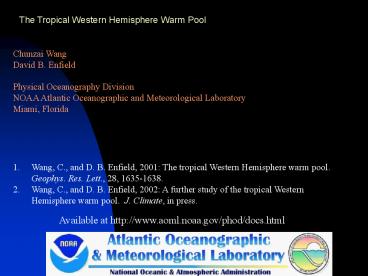PowerPoint Presentation General - PowerPoint PPT Presentation
1 / 18
Title:
PowerPoint Presentation General
Description:
Large WHWPs == low shear == more hurricanes. Knaff (1997) == Warm Caribbean = low shear ... Relation to Atlantic Hurricanes. NOAA Atlantic Oceanographic ... – PowerPoint PPT presentation
Number of Views:76
Avg rating:3.0/5.0
Title: PowerPoint Presentation General
1
The Tropical Western Hemisphere Warm Pool
Chunzai Wang David B. Enfield Physical
Oceanography Division NOAA Atlantic Oceanographic
and Meteorological Laboratory Miami, Florida
- Wang, C., and D. B. Enfield, 2001 The tropical
Western Hemisphere warm pool. - Geophys. Res. Lett., 28, 1635-1638.
- Wang, C., and D. B. Enfield, 2002 A further
study of the tropical Western - Hemisphere warm pool. J. Climate, in press.
Available at http//www.aoml.noaa.gov/phod/docs.ht
ml
2
Outline
- What is the WHWP and Why is the WHWP important?
- Annual variation of the WHWP
- Interannual variability of the WHWP
- A positive feedback for WHWP SST anomaly growth
- Summary
3
The Tropical Western Hemisphere Warm Pool (WHWP)
- Define area of water warmer than 28.5C
- Depth of 28.5C is close to average mixed layer
depth (MLD) - Convenient (a closed region)
- Significant impact on organized tropical
convection (e.g., Graham Barnett 1987)
4
The NCEP SST showing the seasonal variation of
the tropical Western Hemisphere warm pool (WHWP)
5
The Tropical Western Hemisphere Warm Pool (WHWP)
The WHWP is a heating source of summer Atlantic
Hadley circulation
SST (larger than 28.5C)
6
Index of the WHWP
Five of the largest WHWPs (1958, 1969, 1983,
1987, and 1998) have come in the NH summer
following El Niño events (EN 1). However,
large WHWPs fail to develop following four
recognized El Niño events (1966, 1973, 1977, and
1992). The WHWPs of year EN 0 can be large or
small.
7
Rainfall Composites for Early Summer (AMJ)
Nino 1 summers with 4 largest WHWPs. (El
Niño WHWP)
Nino 1 summers without large
WHWPs. Consistent with El Niño effect of Chen
and Taylor (2002)
Difference WHWP effect
8
Relation to Atlantic Hurricanes
- Large WHWPs low shear more hurricanes
- Knaff (1997) Warm Caribbean low shear
9
A clear summer moisture path from warm pool into
the central U.S. (Bosilovich et al. 2002)
Arrows qV (moisture transport) Contour
Evaporation 5 mm/day
10
Warm pools strongly affect climate patterns over
continent
AGCM studies by Inatsu et al. (2000 and 2002)
11
Simple slab model of annual heat budget
Over 7N-27N, 110W-50W, h25 m
Data Sets NCEP SST from
1950-99 NCAR-NCEP surface heat flux from
1950-99 Levitus climatological data
12
Annual Variation of the WHWP SST
Heat storage tendency ?H/?t?CPh ?(SST)/?t QN
net heat flux QN net heat flux considering
penetration
13
WHWP Interannual Variability
Composites of WHWP Warm Events (Dark Contour
Climatology)
July Larger by 96
September Larger by 27
14
Our data analyses suggest that a tropospheric
bridge transfers Pacific ENSO effect to the
WHWP The question is After the ENSO-related
initial warming, what is process that amplifies
WHWP SSTA growth?
15
Correlations between WHWP Variables
R(SST,QLW) is large, negative at zero lag,
suggesting that longwave radiation is a positive
feedback (associated with clouds). However,
3-month lagged positive (negative) correlation
between latent heat (shortwave radiation) and
SST anomalies, suggesting that latent heat
shortwave radiation tend to damp/cool warm SSTA
in the WHWP region.
16
Composite of Longwave Radiation Anomalies
SST and Longwave Radiation Anomalies in the WHWP
Region
17
After ENSO-related initial warming, a positive
ocean-atmosphere feedback operating through
longwave radiation and associated cloudiness is
responsible for WHWP SST anomaly growth
SST Anomalies ()
SLP Anomalies (-)
Convection and Cloudiness ()
Longwave Radiation from the Surface (-)
- It differs from
- Positive feedback through momentum flux ENSO
(Bjerknes 1966, 1969) - Positive feedback through latent heat flux TNA
(Carton et al 1996 Chang et al 1997) - Positive feedback through shortwave radiation
SE tropical Pacific (Philander et al 1996)
18
Summary
- Importance of the WHWP
- A heating source of summer Atlantic Hadley
circulation - Rainfalls in the United States, Caribbean,
Central America, and northern South America - Atlantic hurricanes
- A source of moisture for North America
(Bosilovich et al. 2002) - Subtropical westerly wind of North America
(Inatsu et al. 2002) - Seasonal cycle Surface heat fluxes seem to be
primarily responsible for warming of the WHWP. - Interannual variability A positive
ocean-atmosphere feedback through longwave
radiation and associated cloudiness seems to
operate in the WHWP.































